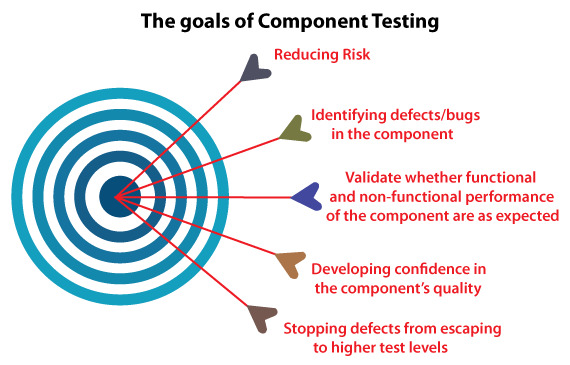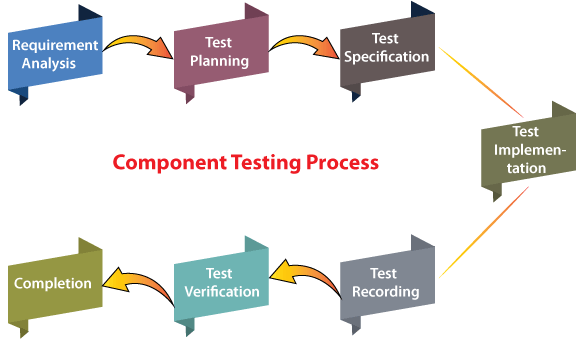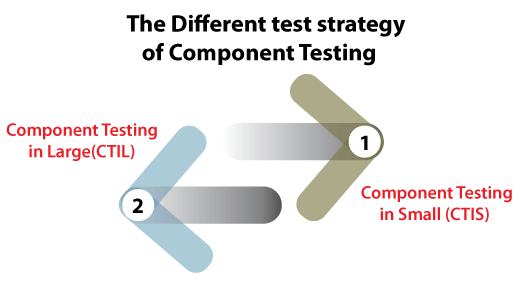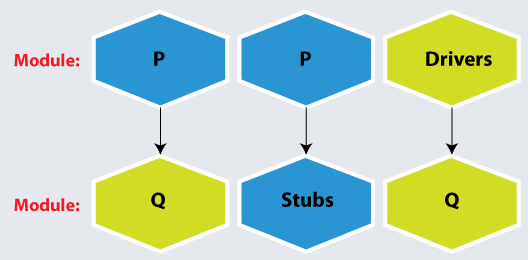A software is developed with the help of several modules or components. Here, we are going to explore and discuss the following topics related to Component Testing, which help us understand the requirement of component testing and product dependability in software testing.
- What is Component Testing?
- The goal of Component Testing
- Who performs Component Testing?
- Component Testing process
- When do we need to perform the Component testing?
- Why Is Component Testing Essential?
- The Different test strategy of Component Testing
- Example of Component Testing
Before going deep into all the topics mentioned above, we are very clear that no matter what, all the testing methods have an objective, and that's why all of those should be performed accurately.
What is Component Testing?
Another type of software testing is Component Testing. It is used to test all the components separately as well as the usability testing; interactive valuation is also done for each specific component. It is further known as Module Testing or Program Testing and Unit Testing.
In order to implement the component testing, all the components or modules require to be in the individual state and manageable state. And all the related components of the software should be user-understandable.
This type of testing provides a way to finding defects, which happen in all the modules. And also helps in certifying the working of each component of the software.

Components testing is one of the most repeated types of black-box testing executed by the Quality Assurance Team.
It can be performed individually, that is, in separation from the remaining system. However, it has relied on the model of the preferred life cycle.
The debugging or test structure tools can be used in the component testing.
In component testing bugs can be fixed as soon as possible when they are identified without keeping any records.
In simple words, we can say that the execution of components testing makes sure that all the application component is working correctly and according to the requirements. Component testing is executed before handing out with the integration testing.
The Goals of Component Testing
The primary purpose of executing the component testing is to validate the input/output performance of the test object. And also makes sure the specified test object's functionality is working fine as per needed requirement or specification.
Let's see some of the other vital goals of component testing:
- Reducing Risk
- Identifying defects/bugs in the component
- Validate whether the functional and non-functional performance of the component is as expected
- Developing confidence in the component's quality
- Stopping defects from escaping to higher test levels

- Reducing Risk
The implementation of components testing validates every single unit of the application. And helps the developers in order to identify the bugs in the code and fix them. Thus, we can say that component testing diminishes the possibilities of risk at a fundamental level.
- Identifying defects/bugs in the component
Another essential purpose of performing the component testing is to identify errors in the source code. Furthermore, it also validates control flow, functions, data structure, etc., which are used in the program.
- Validate whether functional and non-functional performances of the component are as expected
The purpose of executing the component testing is to verify that the functional and non-functional features of the component are functioning correct or not.
In other words, we can describe that the execution of component testing guarantees their design and specifications are performing as expected.
It may involve functional features such as the correctness of calculations and non-functional features like exploring memory leaks.
- Developing confidence in the component's quality
As we understood from the definition of the component testing, it has occurred on the unit level, and most of the errors are identified and fixed while coding itself.
The components testing plays a crucial role in building confidence in the component, which means fewer bugs or defects in the additional testing.
- Stopping defects from escaping to higher test levels
Conclusively, in Component testing, the coding errors are identified and fixed by the developers. And as an outcome, component testing diminishes the existence of errors in the higher level of testing.
Who performs Component Testing?
The component testing is performed by test engineers or the developers who write the codes with IDE help. As we already knew, Unit Testing is executed by the developers to perform the testing of the particular features or methods.
Component Testing Process
The process of component testing can be completed in the following seven steps, as we can see in the below image:

Let's discussed them one by one for our better understanding:
Step1: Requirement Analysis
The first step of component testing is requirement analysis, where the user requirement associated with each component is detected.
Step2: Test Planning
Once the requirement analysis phase is done, we will mov to the next step of component testing process, which is test planning. In this phase, the test is designed to evaluate the requirement given by the users/clients.
Step3: Test Specification
Once the test planning phase is done, we will move to the next phase, known as test specification. Here, we will identify those test cases that needs to be executed and missed.
Step4: Test Implementation
The forth step in the component testing process is Test implementation. When the test cases are identified as per the user requirements or the specification, then only we can implement the test cases.
Step5: Test Recording
When all the above steps have been completed successfully, we will go to the next step that is, Test Recording. In this step of the component testing process, we have the records of those defects/bugs discovered during the implementation of component testing.
Step6: Test Verification
Once the bugs or defects have been recorded successfully, we will proceed to the test verification phase. It is the process of verifying whether the product fulfils the specification or not.
Step7: Completion
After completed all the above steps successfully, we will come to the last step of the component testing process. In this particular step, the results will be evaluated in order to deliver a good quality product.
When do we need to perform the Component testing?
When the unit testing is done on the particular application, we can proceed with the component testing. The components are tested once they are developed; thus, the output retrieved from a component under test depends on other components that are not created so far.
According to the development lifecycle model, component testing might be executed in segregation with other system components.
And the segregation is performed to stop the outside effects. Therefore, we will use Stubs and Drivers to pretend the interface between software components to test that component.
Note: The Integration testing is performed only after the execution of component testing.
The major functionality of all the modules is tested in component testing, such as:
|
Entry criteria for component testing |
Exit criteria for component testing |
|
The least number of
components involved in the unit testing should be created, and unit tested. |
The features of all
the components/ modules should be working fine. And there is no Critical or
High, or Medium severity and priority defects available on the Defect log. |
Why Is Component
Testing Essential?

Allows Detailed Examination
The execution of components testing is allowing the detailed examination once each module or component has been acquired.
It can be tested entirely or exhaustively for all the possible bugs or errors on actual web servers. And this fact is entirely exceptional to the Component Testing as we compared to the Unit Testing where every unit is not tested on live servers.
Early Error Detection
As we understood from the above explanation of Component Testing, it can be implemented at any stage, which helps us identify and fix those errors relatively soon, and as a result, we save both money and lots of time.
And the development team can test the component for all the preventable bugs or defects before giving it over to the quality assessment team.
Certifies Contract
The implementation of Component Testing will help us to certify the contract, which implies that the component testing is repeatable.
So, we can say that component testing is the best way to authenticate our module, which delivers the whole thing that it promised. And as a consequence, any integration with the given software can be performed without any uncertainties and doubts.
The Different test strategy of Component Testing
The Component Testing is separated into the following two types, based on the testing level's complexity.
- Component Testing in Small (CTIS)
- Component Testing in Large (CTIL)

For our better understanding let's discussed them one by one:
1. Component Testing in Small (CTIS)
Some component testing may be performed with or without other modules in the particular application or the software under a test. If the component testing is executed in the segregation with other modules is signified as component testing in small, which is also denoted as CTIS.
Let see one sample example, where we can clearly understand how Component testing in small works.
For Example: Suppose we have one website, which includes five different web pages. Therefore, testing each webpage individually and with the isolation of other components is signified as Component testing in Small.
2. Component Testing in Large (CTIL)
The component testing in large is testing, where we execute the component testing without segregation with having other modules of the software.
This type of testing has occurred when there is a dependency on the performance flow of the modules, and consequently, we can't separate them. Those components on which we have the dependency are not created yet, and then we use the replicate modules instead of the actual modules or components.
Note: These replicated modules are known as the Stubs (called function) and Drivers (calling function).
Let us see an example of component testing in large for our better understanding.
For Example
Let us assume that we have a web application containing three different modules: Module P, Module Q, and Module R.
Here, the developer has created Module Q, which needs to be tested.
However, to test Module Q entirely, some of its features are reliant on Module P, and some of its features are reliant on Module R.
So that, performance flow of the particular modules are as follows:
Module P → Module Q → Module R
This performance flow implies that there is a dependency to Module Q from both Module P and Module R. As we can see in the below image, we have Stubs and Driver where stubs are called as the called function, and the drivers are called as the calling function.

But the Module P and Module R have not been established until now. So, in this scenario, if we want to test Module Q entirely.
Thus, we can interchange Module P and Module R with the help of Stub and Drivers as per the requirement.
Hence, Module P and Module R are primarily changed by stub and Driver that are performed as a replica object until they are created.
Note:
Stub: A Stub is called from the software module or component needed to be tested; as we can see in the above image, Stubs is called by a Module P.
Driver: A driver calls the module/component, which needs to be tested as we can see in the above image that Driver calls module Q.
Example of Component Testing
Suppose we have a web application containing three different modules as Login, Home, and User.
The first module (Login) is installed in the testing environment, but the other two modules, Home and User, need to be called by the Login module that is yet to be finished.
For testing purpose, the developer will add a segment of code that replicates the call methods of the remaining modules. And this specific segment of code is known as Stubs which is considered a top-down approach.
If second module (Home) and third module (User) are ready, but the Login module is yet to be developed, from where both components get their return values, the developer will add a code that replicates the Login module.
And this specific segment of code is known as a Drivers, which is considered a bottom-up approach.
Conclusion
In this section, we have discussed the in-depth knowledge of Component Testing. And, we can conclude that it is an exact way of estimate the functioning of any module at any stage of development.
In software development, component testing is cost-saving and saves an unnecessary headache at a future stage by removing all avoidable bugs.
Al last, we can say the Unit testing and Component testing are executed simultaneously. As opposed to Unit testing executed by the development team, the Component/module testing is executed by the Testing team.
It is always suggested to have complete Component testing performed before starting the Integration testing. Because if the Component testing is accurate, we will identify more minor defects during the integration testing.



0 Comments